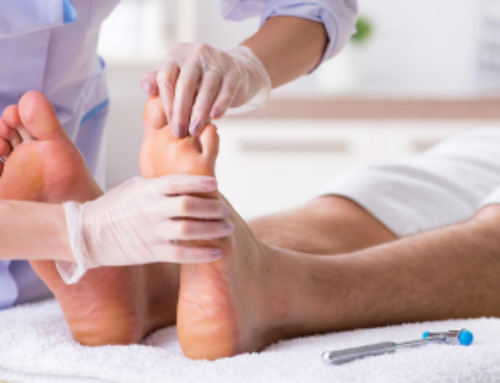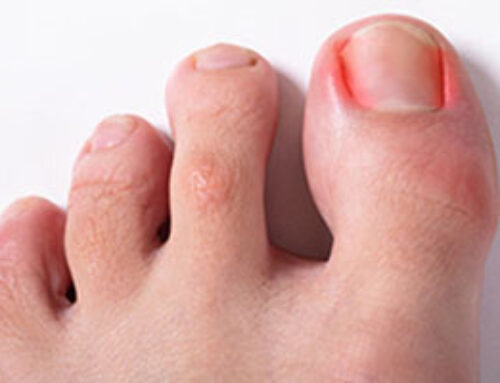When you’re caring for a loved one with type 2 diabetes, routine foot care is as important as keeping blood sugar in check, eating a healthy diet, taking medications as prescribed, and scheduling regular doctor’s appointments. Diabetes can be particularly hard on the feet, but following nine commonsense guidelines can help you keep your loved one healthy and prevent minor issues from becoming serious complications.
Complications of diabetes
Common health complications of diabetes include nerve damage, heart disease, chronic kidney disease, vision loss, hearing loss, and problems with the feet. Fortunately, people living with diabetes can prevent or delay many complications by eating well, staying active, managing blood sugar, and educating themselves about healthy living.
Nerve damage and diabetes
According to the Centers for Disease Control and Prevention, high blood sugar can lead to nerve damage, a condition called diabetic neuropathy. Over time, elevated blood sugar can cause the nerves to stop sending messages to different parts of the body, which leads to mild numbness, pain, or a feeling of weakness in the hands and feet.
The condition is so common that half of all people with diabetes end up with some kind of nerve damage. Maintaining blood sugar as close as possible to one’s target range is the best way to avoid nerve damage.
Heart disease and diabetes
Another common health complication of diabetes is heart disease. According to the American Diabetes Association, people with diabetes are two times more likely to have heart disease than those without the condition. And, heart disease is the number one cause of death in people with diabetes.
The good news is that living a healthy lifestyle—getting the exercise you need, eating a healthy diet, and managing your diabetes—can help reduce your risk of heart disease.
Diabetic foot problems
While foot problems most often occur in those with nerve damage, anyone living with diabetes must pay particular attention to their feet.
Common diabetic foot complications include:
Skin changes. Nerve damage can affect the body’s ability to control natural oils and moisture in the feet. However, applying too much moisturizer can lead to an infection. After bathing and drying the feet, apply a thin coat of petroleum jelly or lotion to seal in the moisture.
Calluses. Handled incorrectly, calluses can break down and lead to foot ulcers. Rather than trying to trim calluses on your own, seek the help of a podiatrist.
Poor circulation. Diabetes can cause blood vessels in the foot or ankle to shrink and harden, leading to poor circulation. This reduces the foot’s ability to fight or heal from infections.
Foot ulcers. Those with diabetes often develop open sores on the ball of the foot or the bottom of the big toe. Neglecting an ulcer can lead to infections or amputation.
Amputation. While people with diabetes are more likely to lose a foot or leg than those without the disease, caring for your feet and wearing proper footwear can help prevent amputations.
How to care for your feet when you have diabetes
When you have diabetes, educating yourself about proper foot care and healthy lifestyle habits can help you avoid infections, protect your feet, and maintain your overall health.
-
Inspect your feet every day
Look for cuts, blisters, redness, or swelling, and pay attention to any problems with your toenails. Though these issues may seem minor, they can turn into significant problems if not treated.
-
Never wash your feet in hot water, and always handle your feet gently
Nerve damage can prevent you from sensing temperatures, which raises your risk of being burned by water that is too hot. Burns can lead to infections and the eventual loss of a foot.
-
Moisturize your feet, but not between the toes
People with diabetes often have dry feet. If you use moisturizer, don’t apply it between your toes, as this can lead to fungal infections.
-
Trim your toenails carefully and consistently straight across
When nails are cut too short, ingrown toenails can become an issue. Scheduling an appointment with a podiatrist to have your toenails trimmed by a professional can lower your risk of developing an infection due to an ingrown nail.
-
Wear socks to bed, and never walk barefoot around the house
Walking barefoot can lead to scratches or cuts that cause significant long-term problems. Always wear shoes or slippers at home.
-
Keep your feet warm and dry
Wear cotton socks without elastic, and change your socks every day to ensure they stay dry. Proper socks absorb perspiration and allow for optimal circulation.
-
Quit smoking
Smoking or using tobacco makes it more challenging to control diabetes. It also raises your risk of developing heart disease, kidney disease, poor blood flow, retinopathy, and diabetic neuropathy. Many health insurance plans offer tobacco cessation programs, and your doctor can help you develop a plan to quit tobacco for good.
-
Wear shoes that fit well
Poorly fitting shoes can cause blisters and calluses. To ensure a proper fit, shop for new shoes at the end of the day when your feet and ankles are at their largest. Only wear new shoes for a few hours each day until they are broken in.
-
Schedule periodic foot exams
Seeing a podiatrist regularly can help prevent diabetic foot complications. Even if your feet are healthy, schedule an appointment with a diabetic foot treatment specialist at least once a year. If you struggle with poor circulation or diabetic neuropathy, it’s crucial to schedule visits more frequently.
Whether it’s time for your annual checkup or you’ve noticed changes with your feet, schedule an appointment with Metro Tulsa Foot & Ankle Specialists today.
Subscribe to stay up-to-date on news and tips from us.





